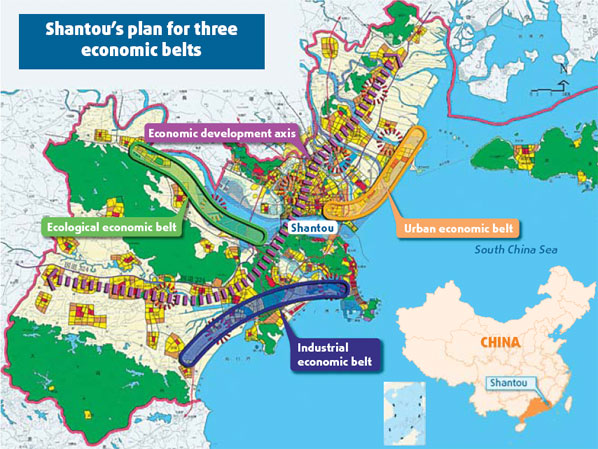
|
BIZCHINA> Center
 |
|
Related
Shantou to develop industrial economic belt
By Qiu Quanlin (China Daily)
Updated: 2008-04-07 11:04  As one of China's four special economic zones, the coastal city Shantou has outlined a "three economic belts" development strategy to build on its leading position in Guangdong province. The strategy includes an urban economic belt in the east, an industrial economic belt in the south and an ecological economic belt in the west. "The strategy, which is of great significance to the city's future development in the next decade, will help develop Shantou into a real environmentally friendly coastal city," says Huang Zhigang, Shantou's Party secretary. The eastern urban economic belt, which starts from the Gulf Bridge in the west to Laiwu in Chenghai district, will be developed into the city's Central Business District, Huang says. With a planned area of 80 sq km along the coast, construction of the belt will begin in October, according to Huang. Of the planned land, about 20 sq km has to be reclaimed from the sea, Huang says. "Shantou has long been affected by limited land resources," Huang says. "So we have to reclaim land from the sea for the new urban expansion development." The city currently has 2,470 people per sq km in its urban area, five times higher than Guangdong province's average. Huang adds that a number of new water facilities will also be built along the eastern coast area to improve the city's flood and drought resistance capabilities. "For years, Shantou has been greatly affected by frequent typhoons. So reclaiming the land from the sea will not only help expand the city's urban area but also enhance its abilities to fight against natural disasters," Huang says. Construction of a 21-km-long sea wall and a 16-km-long road along the coast will soon begin. According to Huang, the application for land reclamation has been submitted to the State Oceanic Administration for approval. "We will also build a long scenic belt along the eastern coast area, providing a real beachscape facing the South China Sea," Huang says. Meanwhile, the southern industrial economic belt, which starts from the bonded zone and Guang'ao Port in the east to Chaonan district, has a planned area of about 117 sq km. According to Liao Xiaoping, deputy director of the Shantou development and reform bureau, the industrial belt will mainly develop heavy industries, including oil and chemicals, electricity, high and new technology, equipment and manufacturing, oceanic industry and logistics. Within the industrial belt, construction has begun on Huaneng Haimen Power Plant, one of Guangdong's key industrial projects during the 11th Five-Year Plan (2006-10). "We will attach great importance to environmental protection for such key industrial projects since they are located also along the coast," Liao says. According to Liao, desulfurizer facilities will also be built along with the power plant, which will be finished by the end of this year. Liao also says that an industry-transfer zone, which will allow enterprises based in the Pearl River Delta Area to move their industries to Shantou, and a Taiwanese-invested industrial zone will be built within the belt. Guang'ao Port, another big project within the industrial belt, has also kicked off construction. A natural deep-water port, Guang'ao Port has so far opened seven international routes to the Mediterranean, Middle East, Philippines and Japan, and 14 routes directly to 25 domestic ports. "More international routes will be opened along with construction of the Guang'ao Port," says Chen Bing, deputy board chairman of the Shantou Port Group Co Ltd. In the past, commercial products manufactured in east Guangdong province, southern Jiangxi province and southwestern Fujian province were usually transported overseas via Xiamen and Shenzhen ports. "We will speed up the construction of the Guang'ao Port and other ports in Shantou, to attract more exporters to transport their goods from here," says Chen. Shantou has planned to integrate nine ports within the industrial belt. It now has 82 berths, each of which has a handling capacity of 500 tons or more. According to Chen, a new railway section connecting to the Shenzhen-Xiamen Railway, which has kicked off construction, will be built. "Rapid development of railways and express roads to connect the port will help make it more convenient for domestic exporters to transport their products from here," Chen says. By 2020, Shantou ports will have a combined handling capacity of up to 100 million tons, according to Chen. Shantou ports have experienced rapid growth in recent years, with 23 million tons of handling capacity last year, an increase of 14.2 percent compared to 2006. In another development, Shantou will also develop an ecological economic belt in the west. Covering an area of about 388 sq km, the ecological belt will mainly develop environmentally friendly agriculture, hi-tech industries, a science and education zone and an urban tourism zone. Chen Yaowu, an official with the Shantou economic and trade bureau, says that development of three economic belts will help attract more overseas and domestic investment. "It has been 30 years since Shantou became one of the economic special zones in 1978. In the first decade, the city saw a fast economic development. But in the following two decades, the economic development here has been stagnant," Chen says. "The development strategy of three economic belts is expected to help the city find a way out for its overall development in the future." (For more biz stories, please visit Industries)
|